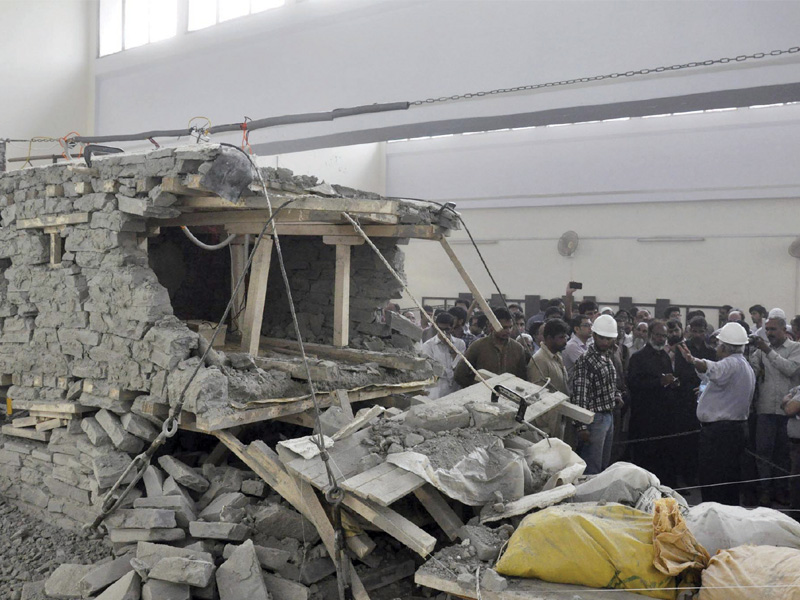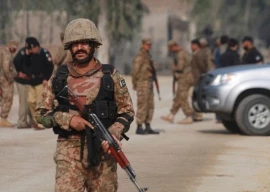
The intense El Centro earthquake that shook the Imperial Valley in Southern California on May 18, 1940, was recreated at the NED University of Engineering and Technology on Friday.
All eyes, as well as cellphone cameras, were fixated at a structure similar to stone masonry buildings that exist in large numbers in the Northern Areas of Pakistan. The structure was placed at the Shake Table testing facility available at the university’s civil engineering department to check the stability of buildings in this part of the world.

“The facility is used to simulate real-time earthquake ground motion to record the dynamic response of a given structure placed on the table,” explained Dr Sarosh Hashmat Lodhi, the university’s civil engineering dean. With his safety helmet firmly in place, Dr Lodhi became busy again as he issued instructions on a walkie-talkie to his team that was present in the control room. They were about to recreate similar ground motions as the earthquake in California.
“The El Centro was a typical moderate-sized destructive event and its ground acceleration record is available to be replicated through the control software at a computer system,” he told The Express Tribune, adding that the records are connected to the Shake Table.
The test project, which is being carried out in collaboration with Aga Khan Development Network, will help experts gain a better understanding of earthquake resistance and collapse mechanisms of a large number of similar buildings that exist in the Gilgit-Baltistan province, which is located on a highly seismic belt. “We will be able to spot the weaknesses in traditional construction methods and suggest low-cost improvements for a majority of underprivileged residents to strengthen these buildings against future earthquakes” said Dr Lodhi.

Given the abundant availability of stones and the low construction cost, most residents use stone masonry in cement or mud mortar with earthen flooring to build single and double-storey residential buildings, he pointed out. “While the region is seismically very active due to its position near the Indian and Asiatic tectonic plates, the uniqueness of this type of construction brings more challenges in the prediction and understanding of its seismic behaviour.”
The organiser transported craftsmen from Hunza Valley along with all the material to make sure the model-structure is as similar as possible to the actual buildings in Hunza. The model was designed to be one-third the scale of the actual stone-masonry houses.
The experiment
The model structure placed on the Shake Table sustained the peak ground acceleration of the El Centro earthquake when the experiment began. It was not until the acceleration was raised to around 150 per cent of the recorded data that the entire structure collapsed.
The structure’s rear part, which is colloquially referred to as ‘chikish’ and designated to store the edibles, took the major impact and turned into debris. While the internal configuration of columns in the traditional construction method helped survive the front part of the building from collapsing completely.
“We will undertake another experiment in the next two months after carrying out strengthening measures in the structure, based on this experiment,” said Dr Lodhi. “Subsequently, the AKDN will be able to implement the findings of these experiments in the region.”
‘Opportunity of a lifetime’
An NED engineering student, who witnessed the collapse, was in awe. “This is an opportunity of a lifetime to witness such an experiment,” he said. For now, the experiment and its findings have been restricted to the Gilgit-Baltistan region but Dr Lodhi hoped to carry on the success of this experiment across the nation in the future.
“We hope to establish a technology transfer mechanism to bridge the gap between research and development to improve predominant traditional habitats,” said Prof. Muhammad Masood Rafi, a co-investigator on the project with Dr Lodhi.
Extend a helping hand
As the death toll from the Balochistan earthquake rises with each passing day, the miseries of the victims is only increasing due to a lack of resources and delayed relief work.
Rescue teams have reached the affected areas and are working round-the-clock to provide aid, here is what you can do to share the burden:
Relief goods

The Pakistan Army is collecting relief goods at the Central Ordinance Depo on Rashid Minhas Road. Apart from this, there are numerous political parties, youth organisations and individuals, who are collecting cash and other relief items.
Buy a ticket

Singer and comedian Ali Gul Pir will be playing at The Second Floor for a charity concert on Sunday. Money earned through the sale of the concert tickets will be used for earthquake relief work.
Donate blood

As many earthquake victims were shifted to Karachi because of their serious injuries, the city hospitals are in need of blood donations. Patients have been shifted to Jinnah, Civil and PNS Shifa hospitals.
Map the disaster

Map the disaster online for the United Nations Office for the Coordination of Humanitarian Affairs which needs this data to assess the situation for relief work. MicroMappers has launched a platform <http://crowdcrafting.org/app/MM_TweetClicker/task/339371> for the UN which is simply tagging of tweets - simple point and click of the mouse.
Start an initiative!

This is the time to do big things - well on a small scale. Start your own campaign in your area, class or office to raise funds. Organise a bake sale, movie screening or gig - get your creative hat on! Use the money to buy relief goods or donate it to an organisation you trust.
Published in The Express Tribune, September 28th, 2013.
COMMENTS (2)
Comments are moderated and generally will be posted if they are on-topic and not abusive.
For more information, please see our Comments FAQ

















I admire the joint effort of AKDN and NED, to get acquainted with the initial consequences of earth quake for the traditional houses that is being built in Hunza since ancient. Even today the tradition of constructing houses is the same as it was locally engineered in ancient by our ancestors. Such sort of experiment will enable us to counter the worst effects of natural force especially seismic. As you that that the literacy rate of Hunza is 100 % and you will find them very flexible, if any prominent changes is suggested by expertise, that may differ from their old traditional way of building.
Proud to be an NEDIAN...